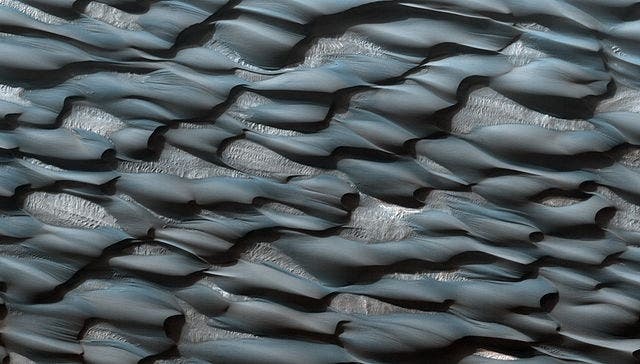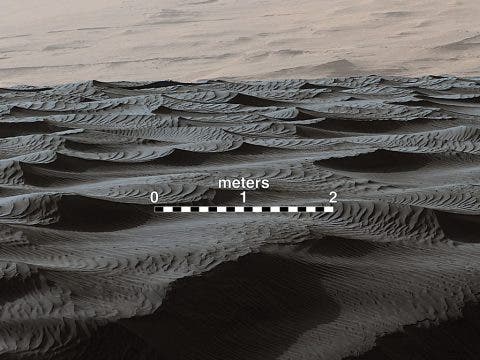NASA’s Curiosity Rover found some of Mars’ sand ripples are of a type not seen on Earth. These wind-sculpted sand formations are distinctly made by Mars’ atmosphere and hold secrets about the Red Planet’s past.

“Earth and Mars both have big sand dunes and small sand ripples, but on Mars, there’s something in between that we don’t have on Earth,” said Mathieu Lapotre, a graduate student at Caltech in Pasadena, California, and science team collaborator for the Curiosity mission. He is the lead author of a report about these mid-size ripples published in the July 1st issue of the journal Science.
Both on Mars and on Earth, we can find the same football field-sized dunes, shaped by sand avalanches with steep upwind faces. There are also the smaller sand ripples — rows of sand less than a foot (30 centimeters) apart which on Earth are formed by wind-propelled sand grains colliding with other sand grains on the ground. These are typically referred to as “impact ripples” by scientists.
NASA researchers were thrilled to find these same formations on Mars after the first high-resolution images beamed back from orbit by the Mars Reconnaissance Orbiter. Judging from these images, the ripples were about 10 feet (3 meters) apart on the dunes’ surfaces, but not much detail could be made from that high above.

Eventually, Curiosity Rover’s wheels touched the Bagnold Dunes on the northwestern flank of Mars’ Mount Sharp. Immediately, NASA researchers back on Earth who studied the new footage found the crest lines of the meter-sized ripples are sinuous. This means Mars’ sand ripples are not at all like the impact ripples seen on Earth, but more like those that form under moving water. Even more amazingly, superimposed on these larger ripples were smaller ripples about the same size and shape as Earth’s impact ripples.
NASA concludes that these meter-sized ripples were built by Martian wind dragging the sand particles akin to how flowing water drags sand particles on Earth. In other words, that’s a totally different mechanism that anything we’ve seen on Earth.
“The size of these ripples is related to the density of the fluid moving the grains, and that fluid is the Martian atmosphere,” he said. “We think Mars had a thicker atmosphere in the past that might have formed smaller wind-drag ripples or even have prevented their formation altogether. Thus, the size of preserved wind-drag ripples, where found in Martian sandstones, may have recorded the thinning of the atmosphere.”
These latest findings investigate modern dunes, but sand ripples preserved in sandstone dating from more than 3 billion years ago were previously investigated by NASA’s Curiosity and Opportunity rovers. Wind-drag ripples about the same size as the ones found at Bagnold Dunes were found, which fits the current narrative that suggests Mars lost its original atmosphere in the planet’s early history. But despite Mars looks nothing like it used to, it still bears many similar features to those found on Earth.
“During our visit to the active Bagnold Dunes, you might almost forget you’re on Mars, given how similar the sand behaves in spite of the different gravity and atmosphere. But these mid-sized ripples are a reminder that those differences can surprise us,” said Curiosity Project Scientist Ashwin Vasavada, of NASA’s Jet Propulsion Laboratory in Pasadena.


